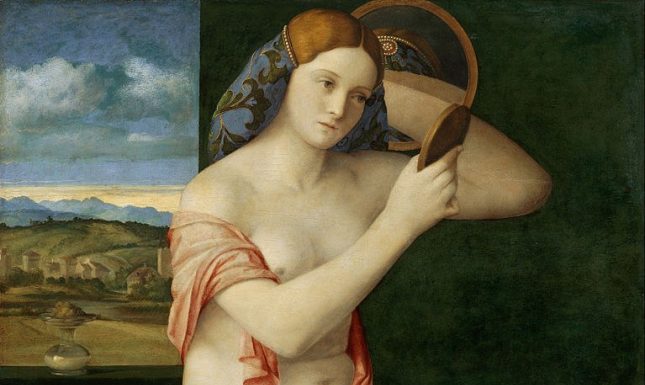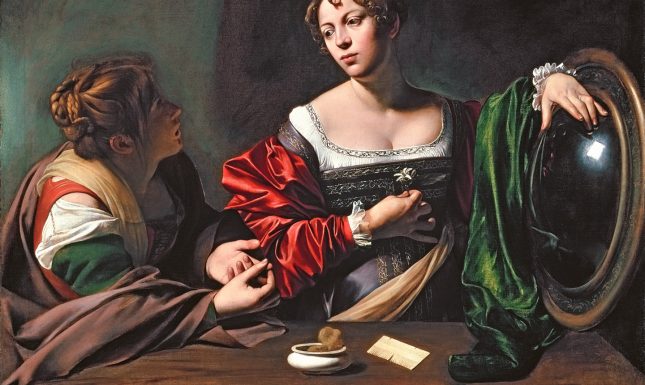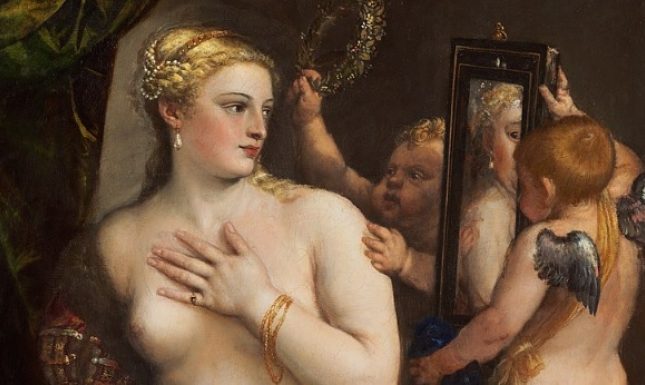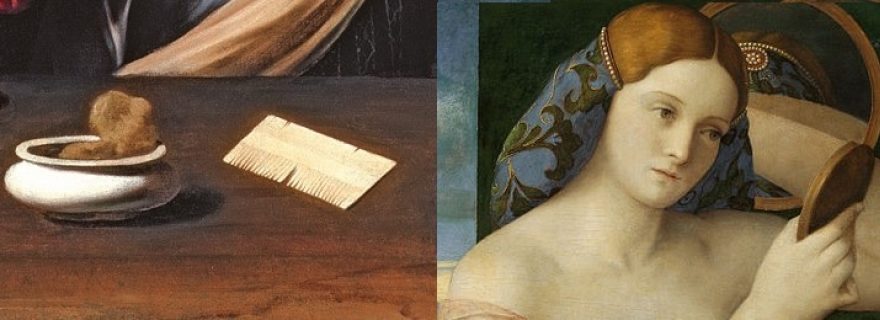Makeup and female beauty standards in Renaissance Italy
In Renaissance Italy, the female beauty ideal included features such as blonde hair and a pale skin. Women tried their best to live up to these expectations, but elaborate makeup and beauty routines were not without risk.
Blonde hair and rosy lips
Courtesy books often offer striking insights into past societies. Take for instance the famous Book of the Courtier by Baldassare Castiglione, which describes the characteristics of the perfect courtier and the perfect court lady. An ideal courtier was a scholar as well as an athlete, educated in Greek, Latin, history, and rhetoric, and able to wrestle, hunt and play tennis. He should be a good soldier, a great councilor, a comedian and a musician – the list of requirements goes on and on, page after page. When the discussion arrives at the courtier’s looks, however, there is not that much to say. All that is necessary is that he is neither too small nor too big, and strong and agile enough to be a warrior. This description of the perfect man of the court stands in sharp contrast with the requirements for the perfect court lady. Women need to be well-mannered and educated enough to entertain men with conversation, but there is no need for them to be knowledgeable of politics and war, and practicing a sport and making jokes are even deemed inappropriate. The one thing that holds no particular value for the male courtier, however, is of paramount importance for the court lady: beauty. As one of the characters in the book states: “good looks are more important to her than to the courtier, for much is lacking to a woman who lacks beauty.”
As I have discussed in a previous blog, good looks were very important in Renaissance Italy, as they could be perceived as an outward reflection of a person’s character. For women, however, good looks were even more essential, as beauty was one of the few things that could enhance their status in society. This preoccupation with female beauty is reflected in works of literature: lyrical poetry, romance epics and novella’s include long descriptions of women’s bodies, described from head to toe. Sources like these, together with works of art, tell us that beauty standards included blonde hair, rosy lips, a pale, hairless skin, white teeth and small breasts. The full array of these beauty requirements often went beyond the reach of ordinary women. Feeling the pressure to live up to their society’s idea of the perfect woman, many of them may have tried to augment their appearance. In another blog, recently updated, I discussed the ways in which women tried to reduce the size of their breasts. In this blog, I will focus on makeup and other beauty products.

Secret beauty recipes
Pietro Bairo’s book of recipes, the Secreti Medicinali, includes cures for medical ailments ranging from toothaches to hemorrhoids, but also contains a wide array of beauty recipes. These recipes are not exclusively targeted at women: some of them aim to whiten the teeth or dye white hair black again, while many others promise to cure hairloss and boldness. Most of the recipes, however, serve the traditional requirements for female beauty:
* For making the hair blonde: cook alum in water, make a poultice and leave this in the hair for two days. Another option: wash the hair with a mixture of lemon juice and the plants yellow lupin and alsem, and the yellow of a figplant.
* For whitening the face: wash yourself with donkey milk (following the famous example of Cleopatra), or make a poultice out of cedar, pig lard, white wax and salmoniac.
* For “making the face red” (probably blush or lipstick): take bulbo marino or dillseed and mix it with old wine or honey.
* For “making the eyes of women black”: dry the flower of the henbane in the sun and grind it together with fine wine. Another option: take the juice of a sweet pomegranate, with the flower and juice of the henbane or nightshade, and wipe it on the eyes.
* To remove unwanted hair: take equal parts of the blood of tortoises, frogs, and owls, together with ant eggs, red orpiment, gomma di hellera, as much as the one as of the other, and mix it with vinegar. Apply it discreetly, so that you don’t flay yourself.
As the disturbing warning at the end of this hair-removal recipe shows, some of these mixtures could be quite dangerous, and I would definitely not recommend trying them at home. Back in the day, these beauty treatments could easily go awry, as is clear from the fact that the rubric on hair removal is immediately followed by one on “what to do when your skin is burned by an ointment”.

Moral criticism and ridicule
Skin burns and eye infections were not the only risks women faced while trying to live up to their society’s beauty standards. Moral criticism could befall them as well. According to the doctrine of the Christian church, augmenting your physical appearance by wearing makeup could endanger the state of the immortal soul. Sources like sermons and manuals for confession show that makeup was deemed sinful for various reasons. First of all, it was a sin because by changing your appearance, you are altering the work of God. In the words of preacher Bernardino da Feltre: “If God has made you black, red, or white, who are you to change and corrupt the work of God with your paints and dyes?” Secondly, a woman whose beauty had been enhanced with cosmetics could seduce men into committing sexual misbehavior – in this, makeup was deemed just as dangerous as dresses with plunging necklines. Some theologians believed that wearing makeup in order to please one’s own husband was not a sin at all, or even commendable, and also stated that wearing makeup to hide “some blemishes” was tolerable. Many others, however, were more strict, and claimed that even women who only wanted to please their husbands could be committing a sin, because their splendor might inadvertently draw the attention of other men as well.
Women who wore makeup were also attacked from a different angle, as male authors ridiculed them for 'trying too hard'. In Pietro Aretino’s satire I Ragionamenti, a courtesan advices her daughter to be very economical in the use of cosmetics, if she does not want to look ridiculous. She says that she is shocked by “those overpainted sluts who varnish themselves like carnival maskers at Modena”. These women try to “smooth away” their wrinkles and rotting teeth with cosmetics, and as they are unable to afford precious ointments like those described in the Secreti Medicinali, they make their skin look white by “besmearing themselves with flour”, and paint their lips red with a thick layer of umber, so “that anyone who kisses them feel his lips burning strangely”. As the courtesan’s daughter is a natural beauty, she has no need of these tricks, only a slight touch of blush suffices. In the Book of the courtier, the same text where it is stated that “much is lacking to a woman who lacks beauty”, women who wear too much makeup likewise become the object of scorn. At first, the discussion seems sympathetic, as it is acknowledged that “every woman is extremely anxious to be beautiful or at least, failing that, to appear so. So when Nature has fallen short in some way, she endeavors to remedy the failure by artificial means.” This, however, is as much empathy as they can expect. Women are mocked for applying a layer of foundation that is so thick that it looks like they are wearing a mask. “They dare not to laugh for fear of causing it to crack, and only change color when they dress in the morning.” These women, it is said, are much less attractive than a woman “who paints herself so sparingly and so little that whoever looks at her is unsure whether she is made-up or not.” Women who cover themselves with makeup “only make it clear to everyone that they are excessively anxious to be beautiful”, whereas a truly beautiful woman shows “no effort or anxiety to be beautiful”. She, however, already lives up to female beauty standards, having a face “which is neither too pallid nor too red, and whose own coloring is natural and somewhat pale”.
We have reached the end of this blog, but not the end of the story. Keen readers will have noticed that this blog was written from a decidedly male perspective; as it described male perceptions and expectations of female beauty. What women themselves thought about this topic will be the subject of my next blog.

Translations:
- The Book of the Courtier: George Bull (London 1967).
- I Ragionamenti: Raymond Rosenthal (Toronto 2005).
© Marlisa den Hartog and Leiden Medievalists Blog, 2020. Unauthorised use and/or duplication of this material without express and written permission from this site’s author and/or owner is strictly prohibited. Excerpts and links may be used, provided that full and clear credit is given to Marlisa den Hartog and Leiden Medievalists Blog with appropriate and specific direction to the original content.


